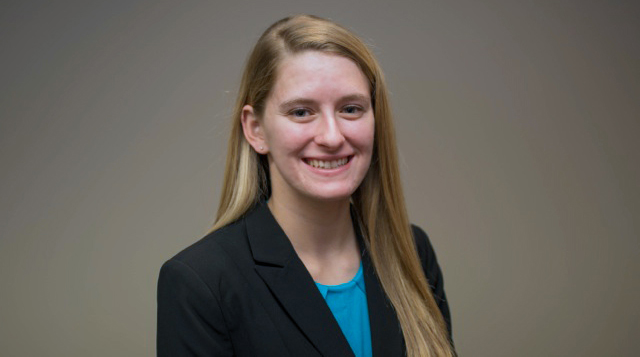4 Questions with Undergrad Rebecca Stern
by Allison McLellan
 1. Why are you interested in Materials Science and Engineering?
1. Why are you interested in Materials Science and Engineering?
My enthusiasm for materials science and engineering began during my primary years of undergraduate education at UConn where I first experienced the beauty of a first-principles approach to solve scientific problems. The elegance of computational materials science stems from the self-sufficient simulations that are free from empirical data or the need to establish present conditions. This means that new materials can be analyzed and scientific challenges can be overcome because the simulations do not rely on prior experiments. Modern computational materials science is only fifty years old, yet promises to yield countless breakthroughs in the fields of medicine, transportation, and renewable energy.
2. How has your research experience and internship impacted your education and professional goals?
In the Fall of 2014 I was selected for a collaborative research project between the University of Connecticut and Pfizer Inc. The goal of this project was to create a new program using ab initio quantum mechanical simulations to predict the solubility properties of drug molecules. My research advisor Dr. Serge Nakhmanson guided me and oversaw my training with the UNIX operating system, which formed the basis of my computational work. For additional preparation, I took the graduate level course called “Modeling Materials” with Dr. Ramamurthy Ramprasad. This course delved into the theory and practices underlying modern electronic structure materials computations, specifically using density functional theory.
In the Summer of 2015 I was selected to be an intern at Pfizer Inc. where I conducted daily research under the guidance of Dr. Geoffrey Wood to help improve the corporation’s ability to predict molecular and solid state properties. Specifically, I focused on computational predictions of pKa numbers-a measure of molecule dissociation in solution.
My interests in conducting research using modeling tools grew during this time as I understood the immense importance of my work and, if successful, the positive effects it could have on drug delivery. Becoming involved in undergraduate research early improved my internship experience and senior year at UConn because I am using the project from Pfizer Inc. for my Capstone Senior Design project. I then felt prepared when applying to graduate school and look forward to continuing my education to reach my career goals.
3. Do you have a role model?
Dr. Lydie Louis is a postdoctoral researcher in Dr. Nakhmanson’s research group who I work closely with on my project for Pfizer Inc. Through this relationship I acknowledged that, although I had come far as a woman in engineering, I still felt influenced by gender stereotypes because I was hesitant to continue materials modeling. Computer science is a male dominated field, but Dr. Louis conducts computational materials modeling research with such elegance that I’ve decided to follow in her footsteps. Dr. Louis has been a magnificent role model for me and has convinced me that my accomplishments and experiences have prepared me for graduate school.
4. What are your future aspirations?
By developing a fundamental understanding of computational materials science, I hope to apply my research to further advanced materials for use in energy management and healthcare. It is my desire to become a leader in this field and to be a contributor in the next generation of advanced material innovations. I am highly driven to continue my education at the graduate level so that I can expand my knowledge and capabilities in order to become an individual capable of meaningful contribution.
Published: February 26, 2016
Categories: news, undergraduate students
Available Archives